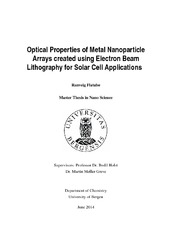| dc.description.abstract | Metal nanoparticles (MNPs) are of key interest in many research fields due to their unique optical properties, which are largely dominated by the localized surface plasmon resonance (LSPR) effect. The LSPR effect gives rise to intense light absorption by the MNP at certain wavelengths of incident light. The LSPR wavelength can be manipulated by changing the size and shape of the MNPs as well as by changing the surrounding medium, opening for a variety of applications such as optical- and biological sensing and solar energy conversion. The company EnSol AS has patented a novel thin- film solar cell technology based on the LSPR effect in MNPs. The University of Bergen, in collaboration with EnSol, has started a project of investigating and optimizing the production parameters of the EnSol solar cell with the ultimate aim of producing model solar cells. As a step in the optimization process, the optical properties of large arrays of nanoparticles need to be investigated theoretically and experimentally. This has been the aim of this thesis work. Large arrays (9 mm2 - 16 mm2) of disk-shaped aluminum, gold or nickel NPs fabricated on non-conductive glass substrates have been fabricated by the means of electron beam lithography (EBL). MNP disks of diameter down to 20 nm have been fabricated. The optical properties of MNP arrays are analyzed for disk diameters in the range 30 nm - 45 nm with a constant height of 25 nm. EBL suffer from low throughput, but offer high control of particle size, shape and orientation which is of prime importance in the development of reliable model system where size- and shape dependent properties are investigated. The large size of the arrays allows optical investigation using spectroscopy techniques, making it possible to mimic realistic operation conditions of the solar cell. The LSPR wavelengths are found experimentally using an integrating sphere set-up. The experimental results are tested and supported by theoretical calculations based on an electrostatic model developed by I. Simonsen and R. Lazzari, where the disk-shaped metal nanoparticles are approximated as spheroids truncated by a glass substrate. Despite the discrepancies in particle shape between the model and experimental system, good qualitative agreement is found. The LSPR wavelength is also found to be in good agreement with published literature that in most cases is based on much smaller arrays. | en_US |
